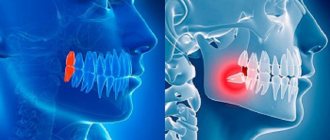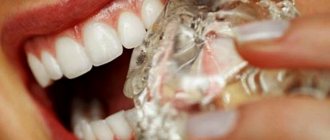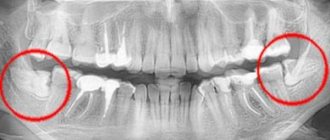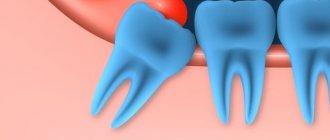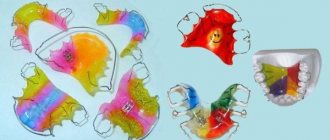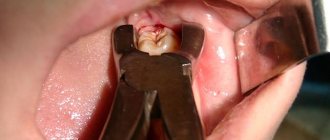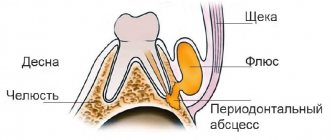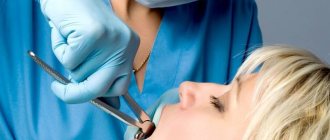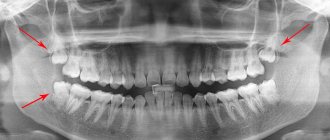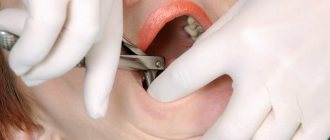Most people aged 17-27 years old face problems caused by the appearance of a wisdom tooth (the so-called third molar or eight). Sometimes it can erupt at a later period. Almost 10% of people do not have them at all, and in a third, they remain in the jaw all their lives in the form of embryonic anlages, never appearing.
However, this process is not always accompanied by pain, discomfort and other problems. Quite often they erupt successfully and retain their chewing function for many years without showing any signs of carious lesions.
What to do if teething still causes discomfort: treat it or is it better to resort to removal? These and other questions will be discussed later in the article.
What are wisdom teeth?
Dentists and scientists call them a vestigial organ, the need for which disappeared when people learned to heat food. Eights, like all other human teeth, consist of roots, a neck and a crown, but despite this they have certain anatomical features.
Here are the main differences:
- they are only indigenous and do not come in milk;
- their eruption is often accompanied by pain;
- have a larger number of roots - from 2 to 5;
- bent and twisted roots.
How to relieve pain when wisdom teeth erupt
The easiest way to get rid of unpleasant symptoms is to take over-the-counter painkillers.
- To relieve pain and fever: Nurofen, Ibuprofen, Nimesulide, Paracetamol.
- To eliminate pain: “Spazmalgon”, “Ketanov”, “Analgin”, “Pentalgin”, etc.
- Antiseptics to relieve symptoms and prevent complications: Miramistin, Chlorhexidine, Furacilin, etc.
- For local pain relief: “Kamistad”, “Kalgel”, “Cholisal”.
You can use folk remedies.
- Rinse solution made from salt and soda. Dissolve 1 teaspoon of salt and soda in a glass of warm water. It is recommended to rinse your mouth no more than 3 times a day.
- Rinse solution made from propolis tincture. Stir 7-8 drops of tincture in a glass of warm water. The solution is also a natural antiseptic.
- Cold compress. Under no circumstances should it be hot - heat may cause inflammation.
- Sage decoction. Pour 1 tablespoon of sage into a glass of boiling water, leave for an hour, strain. You can rinse until relief occurs.
Relieving pain during wisdom tooth eruption is only a short-term solution. A competent consultation with a doctor will help you cope with pain and possible complications.
Common problems that can be caused by wisdom teeth
Most often, problems that arise during the period when eights emerge from the gums are due to the fact that by the time they appear, a person has already formed strong bone tissue, and there is practically no room left for them in the jaw. All this significantly complicates the process of growth and eruption.
A tooth appearing in an already formed jaw can cause the following problems:
- Development of periconaritis. The peculiarity of this pathology is the formation of a “hood”. In addition to the pain that occurs when food gets on the gums and irritates the nerve endings, pathogenic bacteria accumulate in the “hood”, which can cause inflammatory processes in the oral cavity.
- Cyst formation. Dense gum tissue and the space constrained by the formed jaw forces the erupting tooth to grow in the direction of least resistance. Because of this, its roots can grow into the cavity of the maxillary sinus, forming cysts that become infected, inflamed and remain the cause of toothache for a long time.
- Incorrect position in a row (dystopia). As the third molar grows, it can displace teeth that have already erupted. This disrupts the bite and deforms neighboring teeth.
- Caries formation. Eights cause certain difficulties in daily care, as they are located too deep in the oral cavity. Due to poor hygiene, food particles and bacteria accumulate on their surface, creating a favorable environment for the development of infectious processes.
- Damage to the root of an adjacent tooth. During eruption, the third molar puts pressure on the adjacent tooth, thereby damaging its root. This can provoke an inflammatory process or degeneration of dental tissue.
- Incomplete eruption (retention). Impacted third molars can cause quite a lot of problems - they often cause inflammation of the gums and diseases of adjacent teeth.
If the above problems appear, the dentist may recommend resorting to their removal without waiting for the development of more serious complications.
Why are “eights” considered the most “difficult” teeth?
The eruption of third molars occurs at an age when the jaw bones slow down and stop growing, and there is simply not enough space for them in the already formed dentition. In addition, in the place where the “eight” should erupt, there was no milk tooth. Therefore, a person whose wisdom tooth is cutting experiences significant pain, weakness, and lacks appetite. The soft tissues surrounding the tooth become inflamed, and the body temperature rises to low-grade fever.
The process can go on, intermittently, for several months, and inflammation can lead to unpleasant and dangerous purulent complications and other undesirable consequences.
Symptoms and diagnosis
The main symptom indicating activation of third molar growth is pain that occurs when chewing. In the case of the formation of a cyst or “hood,” inflammation develops, which, in addition to pain, can be accompanied by an increase in body temperature, enlargement and soreness of the submandibular lymph nodes, and a headache due to the development of the inflammatory process.
A sign that wisdom teeth are growing abnormally is:
- acute pain in the temporomandibular joint;
- numbness of the jaw and aching pain. This may indicate improper growth inside the bone and possible trauma to the jaw nerve;
- inflammation and enlargement of lymph nodes. As a rule, such a sign indicates that an infectious process has begun;
- redness, swelling of the gums and pain when pressing on it;
- displacement of teeth in a row.
If you have such symptoms, you should immediately visit your dentist for diagnostic measures. Only a specialist can confirm or deny the presence of problems associated with the growth of the third molar.
Diagnosis of an impacted tooth, completely or partially hidden under the gum tissue, is carried out in several ways:
- Palpation and probing;
- Sight radiography - to determine the direction of growth and the number of roots;
- Orthopantomography;
- Computed tomography.
The diagnostic method is determined directly by the doctor; sometimes an examination in the dental chair is sufficient, and sometimes an x-ray is necessary to identify existing problems and predict the risk of their development in the future.
The main symptoms of teething are:
Traditionally, we will start with the most unpleasant symptoms that patients have to face. They arise as a result of the development of inflammation of the gums over a partially erupted wisdom tooth. Depending on the severity of the inflammation, only swelling and redness of the gums may be observed, or they may also be accompanied by suppuration and swelling of the soft tissues of the face (24stoma.ru).
- Swelling of the gum or cheek near the wisdom tooth – swelling of the gums around a wisdom tooth usually occurs as a result of the formation of a “hood” over it. The latter is a section of the gum mucosa that hangs over the crown of the wisdom tooth (Fig. 2). Such a hood is formed when a tooth partially erupts, and dentists call its inflammation the term “pericoronitis.” Inflammation occurs because food debris and plaque accumulate between the hood and the chewing surface of the tooth, i.e. good conditions are created for the growth of bacteria.
If you have an inflammation of the hood - 1) it is necessary to determine the feasibility of saving the tooth, 2) if there are no indications for removal, the hood must be excised, as well as anti-inflammatory treatment prescribed (see below), 3) but if there is not enough space in the dentition, excision of the hood will not solve the problem completely, because After some period of time, the gums will again partially cover the crown of the wisdom tooth, and new inflammation will develop.Important : if your gums are swollen, your wisdom tooth needs to be shown to the dentist urgently. Although with minor inflammation (only swelling and redness of the hood, without suppuration), in some cases you can cope with home remedies, which we wrote about at the end of the article. If you see that pus is oozing from under the hood, or it appears when you press the hood, you need to urgently run to a dental surgeon. In some cases, suppuration of the hood of a wisdom tooth ends with the development of phlegmon of the floor of the mouth or submandibular space.
The same applies to the situation when a wisdom tooth is cut - the cheek is swollen, and not just the gums. This also indicates the development of purulent inflammation and its spread towards the soft tissues of the cheek. In all of the above situations, you cannot self-medicate, postponing a visit to a dental surgeon, because In most cases, no antiseptic rinses or antibiotics help.
- Difficulty opening the mouth is an unfavorable symptom that indicates the progression of purulent inflammation and its transition from the hood above the wisdom tooth to the masticatory muscle. If you don’t immediately consult a dentist, your mouth will open less and less (until it closes completely). As soon as this happens, it will be possible to help the patient only in a hospital setting.
- Painful swallowing is also an extremely unfavorable symptom, which indicates the spread of purulent inflammation towards the pharynx and floor of the mouth. This is a very dangerous place for localization of inflammation, because all this can result in abscesses and phlegmon of the peripharyngeal space, as well as the area of the floor of the mouth. If this happens, you will remember the experiences you receive in the hospital for the rest of your life.
- Temperature during the eruption of wisdom teeth - if a wisdom tooth is being cut - a temperature of up to 37.5 may periodically appear even without suppuration of the hood. In general, the temperature will directly depend on the severity of inflammation, and if suppuration does occur, the temperature may be higher. A slight fever and slight discomfort in the area of the erupting wisdom tooth often appear during periods of decreased immunity, hypothermia, and against the background of colds.
- Painful sensations –
pain is characteristic of any inflammatory process, including inflammation of the hood.
As inflammation develops, pain increases. However, in some cases, a sudden cessation of pain may not be due to the cessation of inflammation, but to the fact that the pus has come out of the confined space, but not out, but into the surrounding tissues. Also, pain during the eruption of wisdom teeth may be associated with a lack of space for eruption. In this case, the erupting wisdom tooth begins to make room for itself in the dentition due to the displacement of the remaining teeth. Those. it puts pressure on the seventh tooth in front, which in turn presses on the sixth molar, etc. That is, teeth shift (almost like during orthodontic intervention). Such tooth movements can also be accompanied by pain.
Pericoronitis and laser excision of the hood: video 1-2
What to do: treat a wisdom tooth or remove it?
Many people are often interested in the question: is it better to use the services of a dentist at the stage of intramaxillary development and remove a rudimentary tooth so that it does not create problems later?
However, most experts agree that preventive removal of eights is unacceptable. When the tooth has erupted correctly and does not cause any discomfort, it can be preserved. The main thing is to carefully observe the rules of hygiene and visit the dentist on a regular basis to monitor and perform hygiene procedures.
Removal is resorted to in cases where conservative treatment methods cannot achieve the desired result.
How to take care of your teeth to avoid problems
- We brush our teeth at least 2 times a day;
- We use dental floss and dental elixir;
- We visit the dentist at least 2 times a year, and also immediately as necessary;
- We regularly carry out the procedure for removing tartar;
- We choose toothpastes on the recommendation of your doctor, and not based on television advertising;
- We refuse enamel-damaging whitening pastes. If desired, a whitening procedure can be performed at a dental clinic.
Doctors constantly remind us of the need to be more attentive to our health. Dental health is an important component of the overall health of the body. The consequences of a careless attitude towards dental health can be extremely unpleasant.
The best dental clinic in Ivanteevka
Specialists at Sanident comprehensive dentistry in Ivanteevka offer a wide range of dental services: from caries treatment to prosthetics and restoration. We have innovative equipment, highly experienced staff, high-quality consumables, and at the same time quite affordable prices and promotions. We give a healthy and beautiful smile to everyone!
You can make an appointment with a dentist at our clinic by calling the phone number listed on the website or by visiting us in person at the following addresses:
- Ivanteevka, st. Novoselki, 4 (Ivanteevka railway station);
- Shchelkovo, st. Central, 80 (railway station Voronok).
Carious lesion of the wisdom tooth and the adjacent “seven”
It takes a lot of effort to really clean teeth that are far from the center, so their level of hygiene usually leaves much to be desired. They do not take an active part in the chewing process, so they also do not clean themselves. In the accumulating plaque, pathogenic microflora very quickly develops, causing the need for treatment of caries. Since, due to lack of space, the “figure eight” is often located obliquely, caries also affects the adjacent tooth - in the area of their contact.
Rules for oral care after wisdom tooth removal
In order for healing to proceed normally, without any additional problems, it is recommended to adhere to the following rules:
- remove the tampon 20 minutes after surgery;
- for 3 hours after removing the figure eight, do not eat or drink;
- Do not rinse your mouth on the day of surgery;
- In the first few days after surgery, avoid hard foods and eat warm, soft foods. Chew food on the other side of the jaw, protecting the wound from foreign particles getting into it. Do not drink anything hot;
- in the first 7–10 days, avoid alcohol (it slows down healing and cannot be combined with analgesics);
- in the first week, do not visit training rooms and swimming pools, do not work in the garden, do not do cleaning, avoid physical activity, especially those associated with bending;
- in the first week do not visit baths, saunas, solariums, or sunbathe in the open air;
- do not heat the socket area (do not use warming compresses), do not use a UHF device;
- Do not brush your teeth for the first 24 hours after surgery, then for 10 days when brushing your teeth, try not to catch the socket with the brush;
- on the 2-3rd day after the operation, make passive baths with chlorhexidine or another antiseptic (spiking the solution into your mouth and tilting your head towards the hole, just hold for a while, then spit), starting from the 4th day - use chamomile or sage decoctions ;
- take only those analgesics prescribed by the doctor, apply cold compresses.
If the pain intensifies or other alarming symptoms appear, you should never touch the socket with your fingers to check its condition. You need to see a doctor: if there really is a problem, he can prescribe an x-ray, and then select a treatment regimen.
Why does the wisdom tooth and gums in the area where it grows hurt terribly?
Inflammation and swelling are observed due to constant compression and injury to soft tissues by growing “eights”. There may be a release of liquid secretion (exudate), an increase in the concentration of lymphocytes and leukocytes, and the appearance of pus. Swelling becomes more extensive when bacterial microflora enters. To prevent complications, if you cannot urgently get to the dentist, you should take a painkiller and constantly rinse your mouth with antiseptic compounds.
When to see a doctor
Wound healing after removal of the figure eight is always a painful process, but sometimes it is accompanied by complications. To avoid causing a serious deterioration in your health, you should consult a doctor if the following symptoms appear:
- the pain intensifies every day, analgesics help little;
- the pain does not go away a week after tooth extraction;
- the pain is not aching, but pulsating, it radiates to the neck, eye, temple, and interferes with sleep. Such sensations are a sign of an inflammatory process; you should consult a doctor immediately;
- swelling does not disappear completely on the 2nd–3rd day after surgery, but, on the contrary, increases;
- temperature rises above 37.5 °C;
- the temperature does not drop to normal on the 2nd–3rd day after surgery;
- an allergic reaction to a hemostatic sponge or analgesics occurs;
- alveolitis (inflammatory disease) occurs in the socket. This happens if a part of the root remains in the hole, a blood clot did not form or was washed out during hygiene procedures, the patient violated the rules of oral care, which is why an infection got into the wound;
- your health worsens on the 2nd–3rd day after the procedure.
